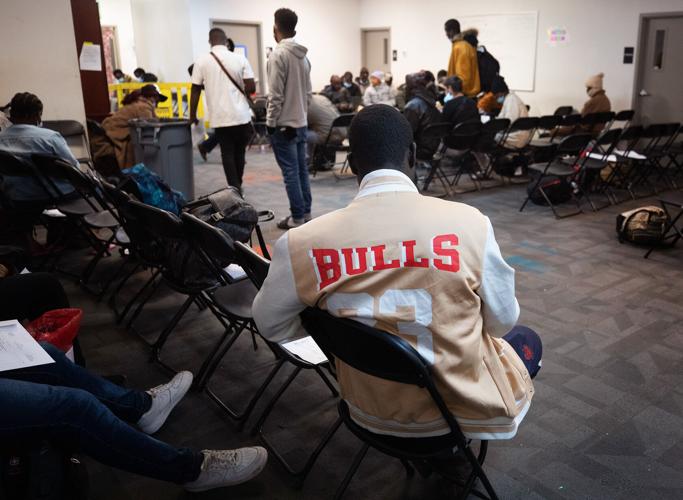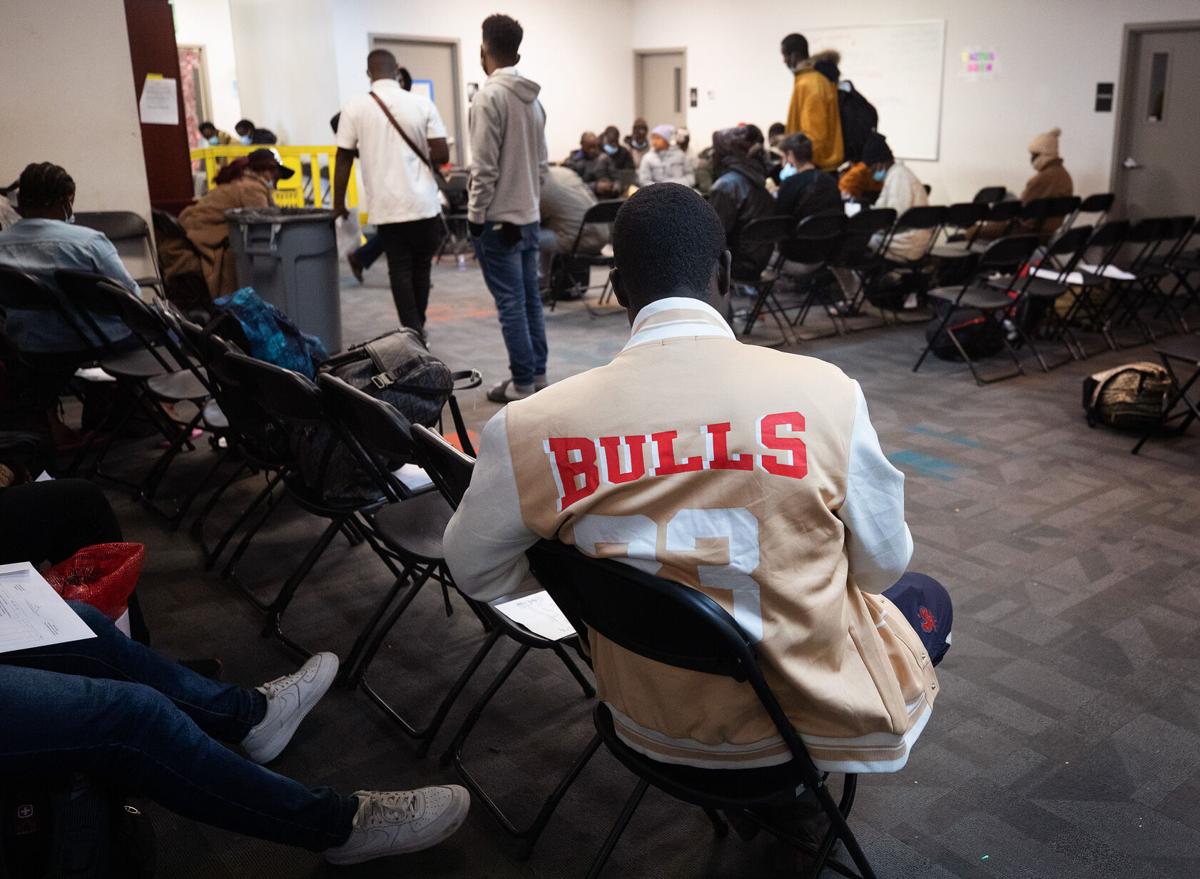In December, a group of Turkish reporters visited us in the Arizona Daily Star newsroom.
One of them asked me about something he’d expected to see in Tucson but didn’t.
The journalist was from a town in eastern Turkey, about as far from the Syrian border as Tucson is from Mexico.
Where, he wondered, are all the refugees? In his home region, refugees from Syria’s civil war have filled the Turkish border towns, inspiring local hostility, he said. But in Southern Arizona, where he had heard of a crush of migrants coming from around the world, even from Turkey, there was no sign of them at all.
He was right. A huge number of migrants has been crossing the U.S.-Mexico border not far from here, up to 3,000 per day in the Border Patrol’s Tucson sector, almost 120,000 in October and November. Many or most of them pass through Tucson. But unless you are involved with them in your job or as a volunteer, you wouldn’t know it.
They arrive in the Casa Alitas shelter on Tucson’s south side, or to a series of motels and hotels that charities use, and they are quickly sent on, mostly through Tucson International Airport or Sky Harbor in Phoenix.

Tim Steller, Metro columnist for the Arizona Daily Star.
“The turnaround is crazy fast,” said Diego Lopez, director of Casa Alitas, which is a program of Catholic Community Services.
How we’ve avoided dire effects is a sort of magic trick — one that Tucsonans have pulled off before and have been executing for a few months during this current surge.
While the threat of “street releases” is ever present, for now, Tucson is reliving the spirit of 2019, less visibly but on a greater scale. That’s the year when thousands and thousands of Central American families fled north through Arizona. Developer Ross Rulney temporarily donated the use of the Benedictine Monastery on North Country Club Road to house and process them.
It was a chaotic miracle, with dozens of volunteers pitching in daily to move people through. But at that time, there were at most a couple of hundred people per day coming through the monastery. In recent weeks, around 1,500 people per day have stayed at or passed through the Casa Alitas center.
“Back then, everything was volunteer run,” Lopez recalled. “Now, with this volume, we can’t have that, for better or worse.”

A migrant looks at a map of the United States at Casa Alitas Drexel Center in Tucson, Ariz., on Jan. 5.
Lopez gave me and photographer Mamta Popat a brief tour of the shelter on Friday. It’s the central node in a system that has largely prevented the chaotic scenes that have played out in some cities in Texas and elsewhere on the U.S. side of the Mexican border.
There are separate areas for single adult travelers and for families, massive refrigerators filled with box lunches, two travel-planning rooms, as well as intake and outflow areas. In past weeks, most of the people passing through have been from Latin American countries, but more recently, many are from West African countries such as Mauritania and Senegal.
About 700 people slept in the shelter overnight Thursday night into Friday, Lopez said, but by the time we were there at 11:30 a.m. on Friday, only about 50 of them were left.
“Now we have the structure and systems, and we’ve been exercising our muscles,” he said.
‘People working really hard’
The success of the current system traces back to a serious fear of failure — failure in this case meaning the mass release of migrants on the streets of towns like Douglas, Bisbee, Nogales, Ajo, and, yes, Tucson.
The chief of the Border Patrol’s Tucson Sector, John Modlin, told me about what happened in an interview Friday afternoon. Since 2021, the Biden administration had been discussing rolling back the Title 42 border policy, Modlin said. That’s the Trump administration measure that used public-health laws to quickly return migrants to Mexico during the pandemic, minimizing asylum claims.
Worried that the repeal of the Title 42 policy would lead to a huge increase in migration, Modlin and others started preparing. He got to know NGO leaders like Teresa Cavendish of Catholic Community Services and Pima County’s emergency manager, Shane Clark. They started preparing for the apparently imminent repeal of Title 42.
“We did table-top exercises,” Modlin said. “We involved all the community stakeholders in those exercises — what would happen, what were we projecting for numbers. We had been around this track multiple times before we got to where we are today.”
The date for the repeal of Title 42 kept being pushed back. It took until May 2023 for the policy to end, and when it did, the effects were not so drastic here. A few days of rush preceded the end, and that was it. Meanwhile, the bulk of migration through Mexico was directed toward Texas.
But then the pattern changed. In late 2023, western Pima County became the focal point of migration through Mexico, especially on the southern edge of the Tohono O’odham Nation and west beyond Lukeville.
The plans that Modlin and the others had made went into effect. Now, when a large group crosses to turn themselves in, Border Patrol agents pick them up in remote areas and take them to gathering spots reachable by agency buses and vans.
Those buses and vans take people to Border Patrol processing centers such as the Ajo, Nogales or Tucson stations, or even farther away in other sectors. There, a file is created on each person, and their names and biometric data are checked — biometric data being fingerprints and facial features.
If nothing untoward comes up for them, the migrants are then sent on buses contracted by the state or Pima County to Casa Alitas or other shelters in the Phoenix area.
In Nogales, migrants are released on the street downtown, but they are adjacent to a building used by Casa Alitas to gather migrants and put them on county-contracted buses.
Even towns like Ajo, which had street releases in 2021, have been relatively unscathed so far this time. Aaron Cooper of the International Sonoran Desert Alliance credited a shift in where Border Patrol processes migrants, and said more broadly, the success is down to “a lot of people working really hard.”
After a night or two at Casa Alitas or Tucson area hotels, they move on, usually by airplane, to their final destinations in the United States, with an obligation to show up in immigration court for their case.
It’s not a reliable way to vet potential new residents of the USA, not a long-term immigration solution. Modlin and others worry about who else is sneaking across the border while agents are busy with large groups who turn themselves in. But it’s been a strong way to prevent chaotic backups in border towns.
Migrant stream takes a toll
That’s not to say there is no regional impact. Especially in the places where migrants stop after crossing the border, they often leave trashed grounds.
In a written statement, Tohono O’odham Nation chairman Verlon Jose said, “There is a serious concern of the environmental impacts the migrants are causing. This includes migrant trash, human waste, burning campfires, and deforestation of the mesquite trees and other vegetation in the area. Other concerns are the constant traffic of buses traveling on the reservation roads.”
But those damages are concentrated near the international line. Beyond there, Tucson International Airport may be the place where everyday Southern Arizonans are most likely to encounter migrants. They’re not hard to recognize, usually in confused-looking groups holding packets of white papers.
About 99 percent of them pay for their own tickets, Lopez said.
“If we open the gates where we’re buying everyone a ticket, or a good portion of folks a ticket, then it gives people the wrong idea,” Lopez said.
The airlines and airport appear to have benefited. Lopez noted that the same-day tickets migrants often buy may cost hundreds of dollars. With up to 700 migrants per day flying out through the Tucson airport in December, they appear to have made up around 5 percent of total passengers at the airport last month.
Local people minimize impact
Of course, it could all break down. Pima County officials have warned that the federal Shelter and Services Program money they rely on to transport people to Tucson will run out at the end of February. After that, who knows?
Sens. Kyrsten Sinema and Mark Kelly demanded in a letter to the Department of Homeland Security that they extend more funding, but both senators’ offices said Friday they had not received any response. Gov. Katie Hobbs is demanding reimbursement from the federal government too, for $500 million in border related expenses.
But these issues are likely tied up in the broader debate in Washington D.C. over asylum law, immigration, border security and funding for Ukraine and Israel.
For now, we can be happy that local people have minimized chaotic situations like those we’ve seen in other places — in the United States and in faraway countries like Turkey.
Get your morning recap of today's local news and read the full stories here: tucne.ws/morning









